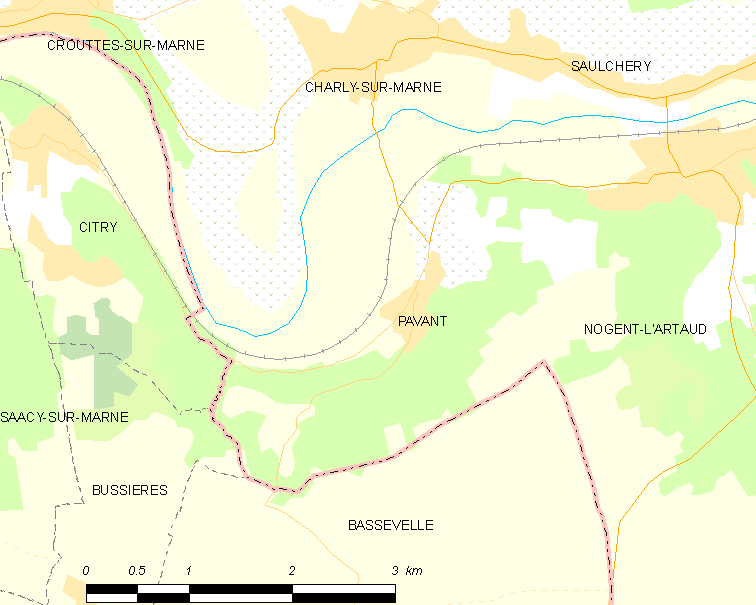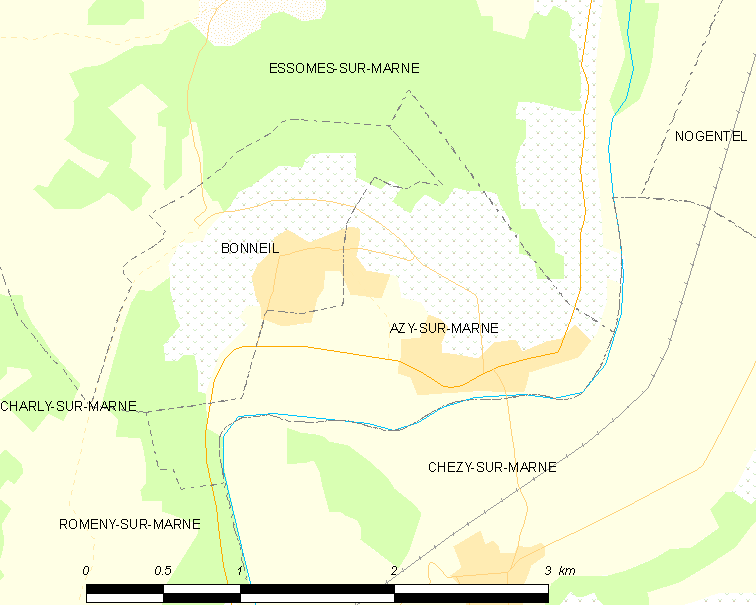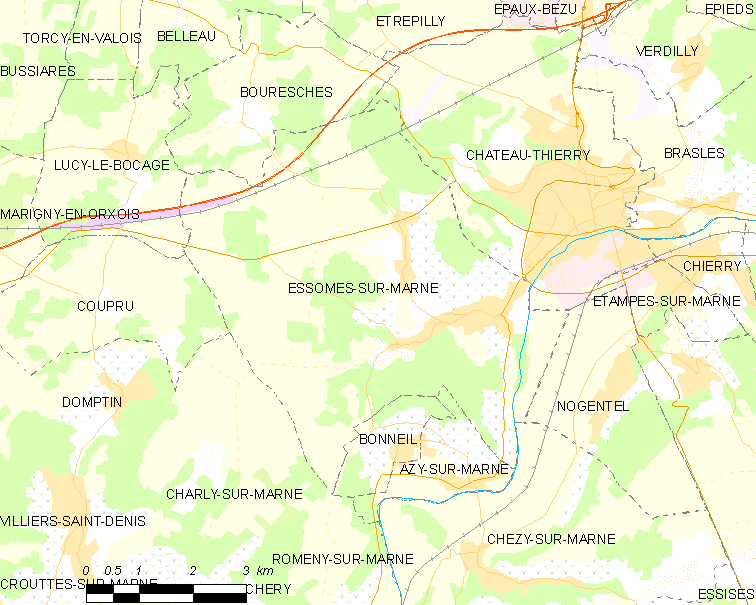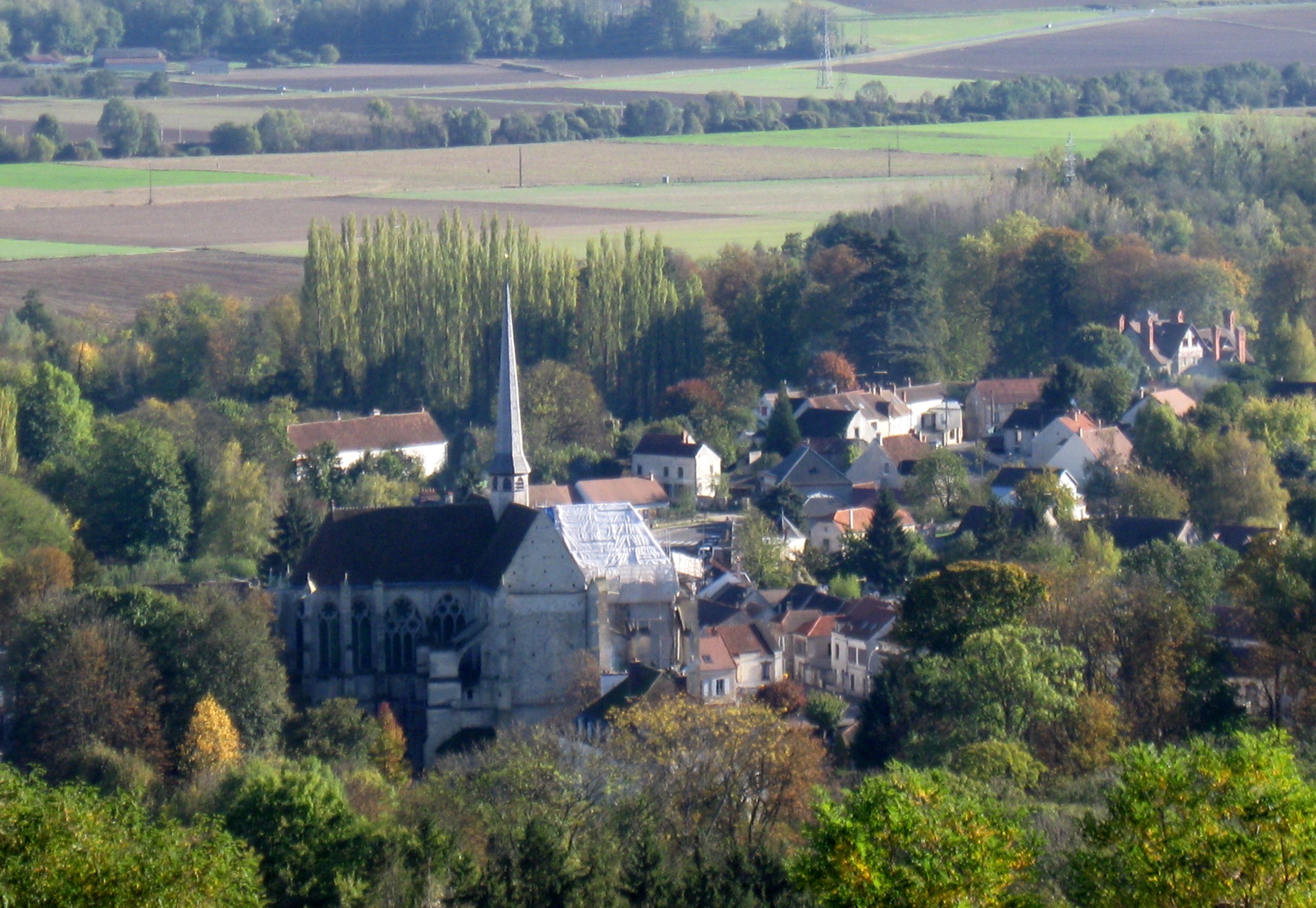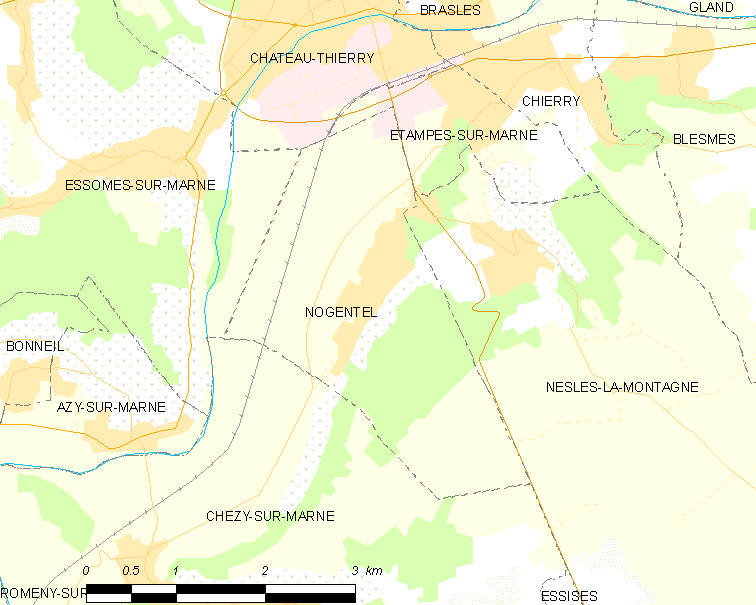 Key facts
Key facts
Located in subregion / area: Vallée de la Marne / Vallée de la Marne Ouest
Vineyards and grape varieties: 363.9 hectares (899.2 acres), of which 75% Pinot Meunier, 16% Chardonnay, 9% Pinot Noir, and 0.2% other grape varieties.
Classification: “Autre cru” (80%)
Maps

The map is linked from Wikimedia Commons, and the geographical information originates from OpenStreetMap. The dotted white area corresponds to the vineyards, light yellow is other open terrain, orange is built-up areas, and green indicates forest. The dashed red line is the departemental border between Aisne (where Charly-sur-Marne is located) and Seine-et-Marne. Note that the main village Charly is located at the letters “sur-Marne” in Crouttes-sur-Marne, just west of Saulchery. The text Charly-sur-Marne is in the rural northeastern part of the commune.
Google Maps view with the villages in the Vallée de la Marne Ouest highlighted, as well as some surrounding villages in white.
Clicking on a village opens a field to the left with a link to the village profile, if there is one.
Neighbouring villages
On the right bank of Marne
East: Saulchery
East: Romeny-sur-Marne (mostly beyond Saulchery)
Northeast: Essômes-sur-Marne
Northnorthwest: Domptin
Northwest: Villiers-Saint-Denis
West: Crouttes-sur-Marne
On the left bank of Marne
Eastsoutheast: Nogent-l’Artaud
South: Pavant
Westsouthwest: Citry
Comment: several of the villages on the map, at some distance from the Marne river, are not included in the list above, since they are outside the appellation and therefore will not be profiled.

The town hall (mairie) in Charly-sur-Marne. Picture linked from Wikimedia Commons (photo Thor19, 2012).
The village
Charly-sur-Marne is located on the right bank of the Marne river, which means to the north of the river. Charly-sur-Marne is the largest village/town directly on the bank of Marne between Château-Thierry and the end of the Champagne appellation in west. The stream Ru de Domptin runs through the commune and empties into Marne at Charly-sur-Marne.
In the Charly-sur-Marne commune, other than the main village Charly, we find the hamlets Drachy (to the southwest, at the 180° bend of Marne), Porteron (to the southwest, consisting of Le Grand Porteron and Petit Porteron), Rudenoise (just to the west of Charly) and Ruvet (to the east, on the border to Saulchery).
The Charly-sur-Marne commune covers 2052 hectares and has 2638 inhabitants (as of 2016) referred to as Carlésiens and Carlésiennes.

The church in Charly-sur-Marne, Église Saint-Martin. Picture linked from Wikimedia Commons (photo Thor19, 2012).
Vineyards
The vineyards in Charly-sur-Marne are found directly at the village and cover a large part of the southern half of the commune. A large proportion of the vineyards are southwest- to southeast-facing slopes, but in the western part of the commune there are also west- and northwest-facing vineyards. The vineyards are continuous with those in Saulchery, Crottes-sur-Marne, and Villiers-Saint-Denis. Pinot Meunier is the dominant grape variety.
The current vineyard surface in the Charly-sur-Marne commune is 363.9 hectares (899.2 acres). There are 272.4 ha Pinot Meunier (74.9%), 58.0 ha Chardonnay (15.9%), 32.7 ha Pinot Noir (9.0%), and 0.8 ha other grape varieties (0.2%). Current information from CIVC as of 2019, refers to the situation a few years earlier. In 1997, the vineyard surface was 305 ha. There are 119 vineyard owners (exploitants) in the commune. The “other grape” varieties are likely to be found in the vineyards of Léguillette Romelot.
There is an association of Pinot Meunier growers in Charly-sur-Marne called La Confrérie du Pinot Meunier de Charly-sur-Marne, with 26 members (as of 2015).
Single vineyard sites
Single vineyard sites in Charly-sur-Marne include the following:
- Les Hauts des Clos du Mont, a mildly southeast-facing site at Drachy and close to the Marne river. Despite the clos name there is no vineyard wall. Fallet Dart produces a vineyard-designated vintage Champagne from this site, composed of 90% Chardonnay and 10% Pinot Noir.
Other single vineyard sites include e.g. Les Boulards, Les Fontenies, Les Hautes Blanches Vignes.
Champagne producers
Other Champagne houses/négociants
The producer status NM = négociant-manipulant means that purchased grapes can be included in the Champagnes. NM producers can be anything from small producers that supplement their own grapes with some that they buy in, to large Champagne houses that primarily rely on purchased grapes. ND = négociant-distributeur, which means that they at least partly sell Champagnes produced by someone else, but under their own name. MA = marque d’acheteur, a buyers own brand.
- Baron Albert (NM, Facebook page), a producer with 55 ha of vineyards in Charly-sur-Marne, Pavant, Porteron, Domptin, Azy-sur-Marne, Villiers-Saint-Denis, and Crouttes-sur-Marne with 65% Pinot Meunier, 30% Chardonnay, and 5% Pinot Noir. The range includes two vintage Champagnes: L’Éclatante which is a vintage blanc de blancs and La Majestueuse composed of Chardonnay, Pinot Noir, and Pinot Meunier. Also produces Champagnes under the brand:
- Jean de la Fontaine
- Baron-Fuenté (NM, Facebook page) which has 38 ha of vineyards. The range includes a vintage Champagne composed of 45% Chardonnay, 40% Pinot Noir, and 15% Pinot Meunier. The Baron-Fuenté group also includes the following brands and are producing for (or have produced for) the following MA brands:
- Sophie Baron
- Charles d’Harleville (MA), which also have been produced by J.M. Gobillard & Fils in Hautvillers, Nicolas Gueusquin in Dizy, Jacquart in Reims, and La Maison du Champagne in Épernay.
- Féty-Simart (MA). There are also bottles with the producer code RC and an address in Villiers-Saint-Denis, which possibly are older.
- Monthuys Père & Fils whose range includes a vintage Champagne composed of 50% Chardonnay, 40% Pinot Meunier, and 10% Pinot Noir.
- Jean de Villaré whose range includes a vintage Champagne composed of 50% Chardonnay, 35% Pinot Meunier, and 15% Pinot Noir.
- Léte-Vautrain whose range includes a vintage Champagne composed of 40% Chardonnay, 40% Pinot Meunier, and 20% Pinot Noir (refers to the 2010 vintage).
- Veuve Duroy (MA)
- Charpentier (NM), has 20 ha of vineyards with almost half Chardonnay, which is unusually much for this area. vilket är ovanligt för området. The range includes a vintage Champagne. There are also bottles with the producer code RM, and I haven’t been able to figure out which are newer. Not to be confused with J. Charpentier in Villers-sous-Châtillon. Also produces Champagnes under the brands:
- Charles Méreuil
- Henri Laurent
- Roberdelph (ND, Facebook page), also Denis Robert on some cuvées. The range includes a vintage Champagne composed of just under 40% Chardonnay.
Champagne growers
Producer status is indicated where known: RM = récoltant-manipulant, or grower-producers. RC = récoltant-coopérateur, growers that are cooperative members but sell Champagnes under their own name.
- Baglin-Coulin (RC, Facebook page), whose range includes a vintage Champagne.
- Alain Bedel (RM, Facebook page), member of Vignerons Indépendants with 7 ha of vineyards. Vieilles Vignes is a vintage Champagne produced using old vines. The 2013 vintage is 100% Pinot Meunier.
- Chatelain (RM, Facebook page), whose range includes a vintage Champagne. Not to be confused with Chatelin Père & Fils, which is a brand produced by Bauchet Père & Fils in Bisseuil.
- Didier Corré (RM)
- Delalot-Drieux (RC, Facebook page)
- De Oliveira Dupré (RM)
- Desimeur-Drieux (RC, Facebook page)
- Carole & Christophe Doré
- Doré Léguillette (RC, Facebook page), has just over 8 ha of vineyards in Charly-sur-Marne and Villiers-Saint-Denis with Chardonnay and Pinot Meunier. The range includes three vintage Champagnes: Millésime which is a blend, a vintage Blanc de Blancs with 100% Chardonnay and Vieilles Vignes which is blended and produced using old vines.
- Drémont-Marroy (RC), which used to have an address in Pavant.
- Jean-Luc Fallet (RM, Facebook page), on the labels written Fallet Jean-Luc, has 5 ha of vineyards with 60% Pinot Meunier, 30% Chardonnay, and 10% Pinot Noir. The annual production is about 35 000 bottles. The range includes a vintage Champagne composed of 75% Chardonnay and 25% Pinot Noir (refers to the 2012 vintage).
- Michel Fallet (RM) with vineyards in Crouttes-sur-Marne, Charly-sur-Marne, and Villiers-Saint-Denis. The range includes a vintage Champagne composed of 1/3 each of Chardonnay, Pinot Meunier, and Pinot Noir (refers to the 2011 vintage).
- Fallet Dart (RM, Facebook page) with 18 ha of vineyards with 45% Pinot Meunier, 30% Chardonnay, and 25% Pinot Noir. The annual production is 160 000 bottles. Millésimé is a vintage Champagne composed of 70% Chardonnay and 30% Pinot Noir (refers to the 2010 and 2012 vintages) and is sold both as a Brut and Extra Brut. The vineyard-designated Les Hauts des Clos du Mont is oak barrel-vinified and composed of 90% Chardonnay and 10% Pinot Noir. It has earlier been sold non-vintage but now carries a vintage year (refers to the 2004 vintage; one blend sold earlier was 2002/2000/1999). The producer’s name was formerly written with a hyphen, as Fallet-Dart.
- Edwidge François (RM), a member of Vignerons Indépendants with 8.5 ha of vineyards with 80% Pinot Meunier, 10% Chardonnay, and 10% Pinot Noir. Magic Vintage is a vintage Champagne composed of 65% Pinot Meunier, 25% Chardonnay, and 10% Pinot Noir (refers to the 2009 vintage).
- Gratiot & Cie (RM, Facebook page), formerly Gérard Gratiot, has 18 ha of vineyards in Saulchery, Charly-sur-Marne, Villiers-Saint-Denis, Romeny-sur-Marne, Azy-sur-Marne, Bonneil, and Essômes-sur-Marne with 84% Pinot Meunier, 13% Chardonnay, and 3% Pinot Noir. The range is divided into the two product anges Almanach and Désiré Gratiot. Almanach No 4 is a vintage blanc de noirs Champagne composed of 83% Pinot Meunier and 17% Pinot Noir from vineyards in Saulchery (refers to the 2008 vintage). Secret d’Almanach is a vintage 100% Pinot Meunier from Saulchery (refers to the 2012 vintage) which is partially (30%) oak barrel-vinified and where the dosagen is made up of 2 cl Pinot Meunier grape must per bottle. Désiré Gratiot Millésimé is a vintage Champagne composed of 66% Pinot Meunier and 34% Chardonnay (refers to the 2008 vintage). Désiré Gratiot Rosé de Saignée is a vintage rosé composed of 53% Pinot Noir, 34% Pinot Meunier, and 13% Chardonnay (refers to the 2014 vintage).
- Patrick Gratiot (RC, Facebook page), also written Patrick Gratiot & Fils, with 11 ha of vineyards in Charly-sur-Marne and Villiers-Saint-Denis with mostly Pinot Meunier. The range includes a vintage Champagne. The company name is Gratiot-Guibert.
- Gratiot-Pillière (Facebook page) with 18 ha of vineyards in Charly-Sur-Marne, Saulchery, Bonneil, Azy-sur-Marne, and Château-Thierry. The range includes three vintage Champagnes: Millésime composed of 55% Pinot Meunier, 28% Pinot Noir, and 17% Chardonnay (refers to the 2012 vintage), a vintage Blanc de Blancs, and Héritage which is composed of 58% Pinot Meunier, 30% Chardonnay, and 12% Pinot Noir (refers to the 2012 vintage) from old vines and which is oak barrel-vinified.
- R. Guibert (RC, Facebook page), whose range includes the vintage Champagne Prestige. Should be on its way to become an RM producer.
- Louise Huvier (RC), with the company name Odile Huvier.
- Laforge-Testa (RC, Facebook page), whose range includes a vintage Champagne composed of 55% Pinot Noir and 45% Chardonnay.
- Jean-Pierre Léguillette (RC), whose range includes two vintage Champagnes, of which one is a blanc de blancs.
- Léguillette Romelot (RM, Facebook page) with 8 ha of vineyards. This includes 0.8 ha of the three grape varieties Arbane, Petit Meslier, and Pinot Blanc, which were planted in 2006. So far these rare grape varieties make up 20-25% in some of their Champagnes. Symphonie is a vintage Champagne composed of 72% Pinot Meunier, 27% Chardonnay, and 1% Pinot Noir. Used to be an RC producer.
- Paul Lenoble (RC, Facebook page), whose range includes a vintage Champagne.
- Bernard Naudé (RM), a member of Vignerons Indépendants with 8.5 ha of vineyards in Charly-sur-Marne, Bonneil, Saulchery, and Romeny-sur-Marne with 75.5% Pinot Meunier, 17.5% Pinot Noir, and 7% Chardonnay. On the labels we also find the text Tour Napoleon which refers to a tower, built in 1830, featuring two statues of Napoleon which is a part of their building. The range includes two vintage Champagnes: Esprit (also named Assemblage) composed of 1/3 each of Chardonnay, Pinot Meunier, and Pinot Noir (refers to the 2009 vintage), and Blanc de Noirs which is 100% Pinot Noir.
- Christian Naudé (RM, Facebook page), a member of Vignerons Indépendants with 6.5 ha vineyards between Charly-sur-Marne and Bonneil. The company name is Du Clos Taupin.
- Naudé-Touret (RC, Facebook page), whose range includes a vintage Champagne.
- Romelot-Poupart (RC, Facebook page), with 7.5 ha of vineyards in Charly-sur-Marne and Villiers-Saint-Denis. The range includes the vintage Champagne Magie.
- Michel Sirot
- Sirot-Ferrand
- Jacques Sonnette (RM, Facebook page), has just under 8 ha of vineyards mostly in Crouttes-sur-Marne and Charly-sur-Marne with 65% Pinot Meunier, 25% Chardonnay, and 10% Pinot Noir. The range includes a vintage Champagne composed of 49% Chardonnay, 44% Pinot Meunier, and 7% Pinot Noir (refers to the 2012 vintage).
- Sonnette-Petit (RM, Facebook page), whose range includes a vintage Champagne.
Comment: the list may be incomplete.
Cooperatives
When bottles are sold directly by a cooperative the producer status is given as CM = coopérative de manipulation, as opposed to RC when sold by a cooperative member under their own name.
- Coopérative de Pressurage Rudenoise is a cooperative in Charly-sur-Marne.
Links
- Wikipedia about this village in English, in French.
- Website of the Charly-sur-Marne commune.
- UMC’s village profile of Charly-sur-Marne.
- Vineyard map of Charly-sur-Marne at weinlagen-info.de.
- Swedish version of this post.
© Tomas Eriksson 2019, last update 2019-03-25


